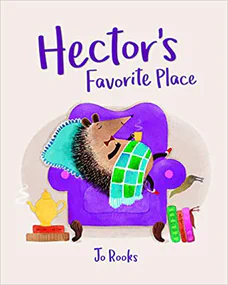Hector’s Favorite Place

Recommended Age Range: Preschool through 2nd grade.
Publisher's Summary:
Hector loves his cozy, snuggly, safe home. It’s his favorite place to be. Hector loves his home so much that he doesn’t often go out, and soon, it starts to affect his friendships. Can Hector find the courage to break out of his comfort zone?

Dr. Annie's Takeaways
Recommended for: Ideal for introverted kids who enjoy staying home and relaxing (nothing wrong with that!) but who feel anxious when they’re expected to try new things or interact with other kids. Hector has a lot of worries that cause him to tell his friends that he’s “too busy” to hang out (in reality he’s going to take a nap or read a good book), but he ultimately realizes he’s missing out on fun things and braves his worries to join his friends. Good introduction to the techniques of exposure
and visualization
.
Would a child like it? The story is sweet and Hector is very cute. It’s not a super scintillating story, but many kids will relate to it, and it is adorable to picture a hedgehog in a bowtie ice skating.
Tone: Upbeat, cute
Story Quality: This story is charming, perhaps particularly so to anyone (adults included) who relates to Hector’s homebody inclination. There’s nothing dark about it, and everything turns out well, but it sweetly articulates the losses that worry can cause (Hector misses out on fun activities with his friends because he is worried something might go wrong and so stays home) and portrays a path forward through worry.
Illustrations: The illustrations are adorable–colorful, cute, anthropomorphized woodland creatures with an artful flair.
Representation: Hector is a male hedgehog with male squirrel Archie and male rabbit Max as friends. Hector appears to be an adult–he lives alone. Hector enjoys reading, painting, and playing piano and is happy being at home by himself (he is decidedly not depressed). He worries about going out and catching the flu, falling and hurting himself, getting lost, music being too loud, hot chocolate being too hot, and not dancing well. These worries prevent him from going for a walk in the snow and ice skating with friends, and they almost prevent him from going to a party.
Psychological Practices: Hector is happy being at home, and he has a lot of worries about going out, so he often says that he’s too busy when his friends invite him to hang out. This is an opportunity to start talking about avoidance and how this can perpetuate anxiety. Hector’s turning point is when he realizes how much he’s missing out on because of his worries, and he commits himself to being brave and going to a forest party with his friends. It’s a good exposure
–he feels nervous, uses visualization to picture himself dancing and having fun, and ultimately joins the party and has a great time. Most of his worries didn’t come true, and the one that did (falling while ice skating) wasn’t as bad as he thought it would be (“being a hedgehog meant falling over didn’t hurt one bit”). I appreciate that the story included two types of expectancy violations
–most of is feared outcomes didn’t occur, and the one that did wasn’t as bad as he expected.
Concerns: Nope
